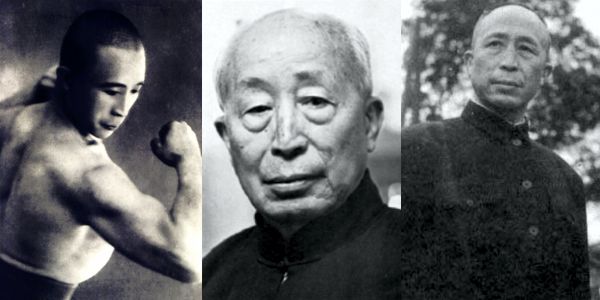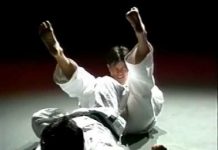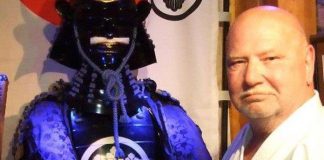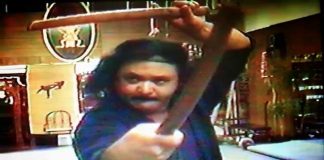Grand Master Tung-Sheng Chang was born in 1908, the year of the Monkey, in Hopei Province in the northeastern section of China, long known for the great martial artists produced there. Of all the masters coming form this region over the past 2,000 years, one of the most pre-eminent is the legendary Grandmaster Tung-Sheng Chang, perhaps the greatest fighter in the last 300 years irrespective of style and certainly the most tested and proven one in this century.
“Grandmaster Chang started serious training in Kung-Fu in 1915 when he was 7 years old. He learned the basics from his father and grandfather, but later, his teacher was the famous Master Chang Feng- yen who was well know as the foremost expert in Pao-Ting Shuai-Chiao, the fastest and most powerful of the three main branches of the ancient art. Chang Feng-Yen was the top disciple of Ping Jing-yee who, like Grandmaster Chang, was a legend in his own time. General Ma, the first of the great masters to compile ancient Shuai Chiao techniques for publication, was another prestigious student of Ping Jing-Yee.
“Grandmaster Chang has often stated that Master Chang Feng-Yen was the best teacher in that time regardless of style, and as a result, many of the most promising young students wished to study with him. Of many who came before Master Feng-Yen to exhibit their basic skills, very few were chosen. Grandmaster Chang was not only one of those few, but by the time he was 17, he was already declared a Master himself. He had attained proficiency unmatched by any of his peers, was the favorite pupil of Master Feng-yen, and had married his Master’s second daughter.
“When Grandmaster Chang was about 20 years old, he left Hopei Province and went to Nanking to study at the central Kuo Shu School, the best in all China, in order to learn all the major styles of Kung fu. Since the best instructors and students from every major style were represented there, admission was an honor and it exposed the practitioner to the widest possible cross-section of Chinese Marital Arts knowledge that could be found anywhere. In a phrase, if it wasn’t practiced there, it probably wasn’t worth much. Once again, Grandmaster Chang’s compatibility’s were such that after 5 years of training with the best students in all China, he emerged at the head of the program and became a teacher of the Shuai Chiao Department, having also mastered the styles of Hsing Yi, Lo Han, Tai Chi, Pa Kua, and most elements of Shaolin in addition to his own.
“At one point, he went to challenge the Mongolian champion at their annual meet in Chang-Chia-Kua. In doing so, he had to fight the well know Hukli, a giant of a man standing well over six feet tall and weighing almost 400 pounds!
“Grandmaster Chang agreed to use only wrestling techniques, and despite the difference in size, repeatedly countered dozens of attacks by the Mongolian champion while throwing him down again and again with a variety of beautifully executed moves.
“In 1933, at the age of 25, Grandmaster Chang entered the fifth national Kua Shu Elimination Tournament in Nanking. This no holds barred competition involved over 1,000 participants and included masters in all major styles from all over China battling each other of supremacy in all-out combat. Grandmaster Chang won all of his matches, including one over his archrival, Liu Chiou-Sheng, and emerged as the Heavyweight Grand Champion. Significantly, this was the last great tournament of its kind where masters who were trained in the old ways fought in an anything goes matter to determine the very best among them. This national meet was considered to be the severest test of the ability, strength, and skill of any fighter and the winner was fully acknowledged to be the undisputed champion of all China. Such open, free style, no holds barred tournaments on that scale were never held again, leaving Grandmaster Chang the last truly tested fighter open to challenge by anyone regardless of style or system!
“Both before and after his brilliant victory in the national tournament, Grandmaster Chang traveled frequently. His intent was to seek out different teachers all over mainland China that were known to be famous for certain techniques or movements. It has been said that he studied with most of the best living masters, humbly playing the role of student even though he could defeat them. He continued this quest until he learned the specialties of the 70 different teachers and was satisfied that the techniques he know were the best in existence.
“During World War II, Grandmaster Chang trained elite units of the military where he eventually rose to the rank of Lt. General. His exploits during this time are a story alone and would take a book to recount. Just one aspect of his many experiences involved challenging all of the top Judo experts at the Kuang-Si Province prison camp. Over a thousand prisoners were interned there and amused themselves by practicing Judo all day long. After challenging and beating the Chinese guards, they were confronted by Grandmaster Chang who had heard of the prowess while teaching in Kue-Lin, the capital of Kuang-Si Province. Grandmaster Chang fought every one in turn, including three high-ranking champions, Hakayama Taido, Hisa Kuma, and Hichi Masao, and defeated each of them handily.
“In 1948, the national athletic meet was held in Shanghai. Unlike the tournaments before the war when hundreds of great masters were still living (many died in the war), the meet was not an open, free-style, anything goes contest. In conjunction with this major change, Shuai-Chiao was now an independent contest. No other styles were allowed as with the last Kuo Shu Elimination Tournament mentioned earlier. Even with the limitations, the scope of the contest was large. Participants came from 32 provinces, 12 special municipal cities, 9 overseas Chinese teams, and 58 military police units! Grandmaster Chang, now 40 years old, represented the army and easily won the overall championship, proving he was still the number one even after 15 years had passed!
“Having won two national tournaments and proven himself countless times in matches, both friendly and otherwise, Grandmaster Chang went on to teach at the Central Police Academy in Taipei for nearly 30 years. During that time he was also Chief Official for all of the national tournaments on Taiwan and Shuai Chiao advisor for the military, police, and the educational system. Though many Kung-Fu styles are taught in Taiwan, none have the prestige of Shuai Chiao. The Taiwan Shuai Chiao Association boasts over 30,000 members, which makes it the largest Chinese martial arts organization in the world!
“In April, 1975, Grandmaster Chang, then 68 years old, was invited to Morocco to give an exhibition of the Chinese arts to the King (Grandmaster Chang’s faith was Islam). During his visits, a 4th degree Tae Kwon Do instructor in service to the King as head of his personal bodyguards challenged Chang and Chang accepted. The match lasted only seconds as Grandmaster Chang deftly dodged the attack of the Korean and knocked him unconscious with a slap of the hand! Obviously, the years had not diminished the physical power and skills acquired from being trained by masters from the previous century, the likes of which now exist only in a small handful of very old men.
“In February 1982, the Grandmaster organized the International Shuai Chiao Association and spent much of the time promoting his art by traveling throughout the world giving demonstrations, workshops, and seminars. In June, 1986, at the age of 78, the martial arts world was saddened by his untimely death.
“The extent to which Grandmaster Chang was respected, revered, and feared by the Chinese martial arts community is incalculable. He was literally regarded as a national treasure by Taiwan and was the only Master to be granted Red, White, and Blue Belt, the national colors of Taiwan. The belt was buried with him and will never be awarded again. Since the knowledge and the caliber of men needed to train someone as Grandmaster Chang was trained no longer even exist, the 10 Degree was retired upon his death. Ten years later the belt was rewarded to Grandmaster Gene Chicoine in 1996 at the national remembrance of Grandmaster Chang. Some say that as much at 60% of all Kung-Fu knowledge that existed in the earlier years of this century went to the grave with Grandmaster Chang!
“In perhaps all of Chinese martial arts history, no one ever went totally undefeated for well over half a century, certainly not if they accepted any and all challenges as Grandmaster Chang did! Indeed, he was not only just one of a kind, but unfortunately for all of us, Grandmaster Tung-Sheng Chang was one the likes of which will never be seen again. Amid all of the competing and conflicting claims made by latter-day teachers as to whose styles or system is superior, no one except the disciples of Grandmaster Chang can state that their teacher defeated the teachers from all styles at a time in history when the deciding factor in victory was who walked away!
“Master Chicoine, who was chosen by Grandmaster Chang to lead the Shuai-Chiao family into the 21st century, was taught 72 techniques, a combination of blocks and strikes before the throw was affected. He was commissioned to teach these techniques to the entire Shuai-Chiao practitioner, 12 of which were for killing only, so that Shuai Chiao would remain the most feared combat style and always be impossible to defeat in real fighting. Here again in victory, Shuai Chiao will be the ones who walk away.”
Editors Note: Tung-Sheng Chang died in 1986 of aggressive esophageal cancer.
By Nelson Wings






